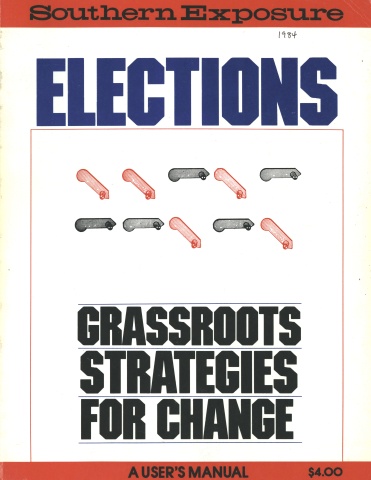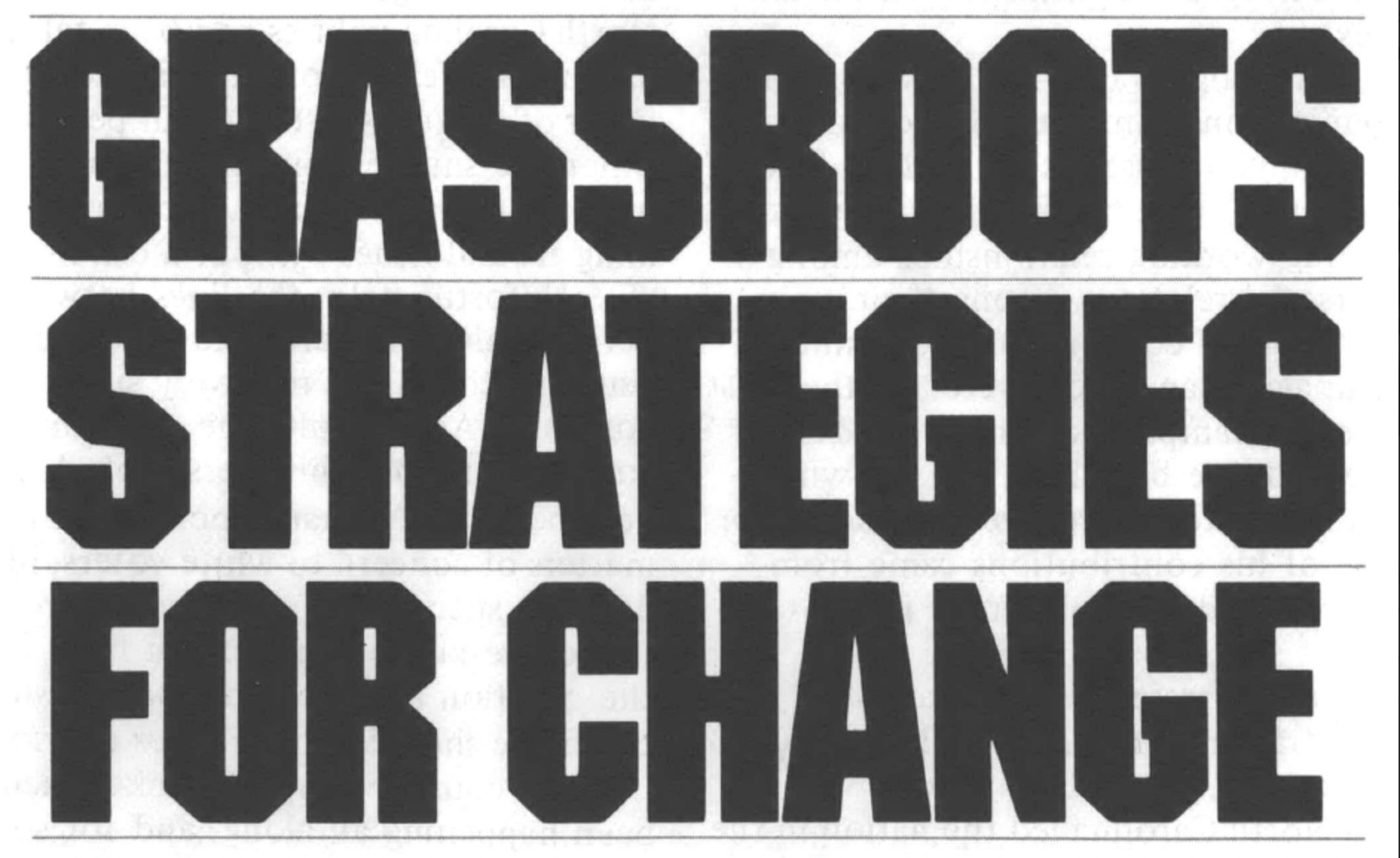
This article originally appeared in Southern Exposure Vol. 12 No. 1, "Elections: Grassroots Strategies for Change." Find more from that issue here.
When a million people march for peace, when an overwhelming majority of Americans favor equal rights for women, when most people cherish the environment — but still the government's policies put property rights over human rights, we need to rethink our strategy for change.
In 1980, Ronald Reagan won the presidency, capping a decade-long slide to the right in American politics. The Senate went Republican and the House, never a progressive stronghold, offered only a sanitized Democratic version of the policies of the president. In state after state, city after city, similar patterns were repeated. Not only was the White House out of reach, but local officials became less and less responsive, both in their own views and because they had fewer resources themselves with which to bargain. As the Right organized and as the economy moved into depression, pressure politics Sixties-style — marches, sit-ins, occupations, even door-to-door nitty-gritty organizing — lessened and produced fewer and fewer gains.
Therein lies a personal conversion. I got tired of losing.
Today, we need to unite protest politics and our organizing around specific issues with the single mechanism provided for Americans to choose who will make a great number of the social, economic, and political decisions affecting their lives. Elections, lobbying, and disciplined political organizing are not a complete recipe for progressive change, but these are skills and techniques we must master and use if we are serious about changing who controls this nation. We must not only begin to pressure the people in power, but become the people in power.
The idea for Elections: Grassroots Strategies for Change emerged from my own involvement in a painful defeat. In the 1982 congressional elections in North Carolina's second district, Mickey Michaux, a liberal black U.S. attorney from Durham, ran a strong campaign for the Democratic nomination. He led his two white opponents in the primary with 45 percent of the vote in a district where 36 percent of the Democrats are black. In the runoff election, Michaux picked up few new votes, and the white arch-conservative, Tim Valentine, now sits in Congress.
Although Michaux lost, many progressives were spurred by their experiences in the campaign to think more boldly about what is possible and what to do next.
First: the campaign was bi-racial, with white and black organizations contributing thousands of volunteer hours and thousands of dollars. The campaign was a step — not the first, but a major one — in building working relationships among groups and personal relations among their members. But the bi-racial cooperation was limited within the campaign plan. There were, for the most part, two different campaigns: one by blacks for the black vote and one by whites for the white vote. And despite white progressive enthusiasm for Michaux, most of his contributions came from blacks and he received only about 10 percent of the white vote.
Second: the campaign relied heavily on a large voter registration drive. Although Michaux lost, several thousand new black voters were registered, and North Carolina led the nation in the number of new blacks elected to the state legislature (from a pitiful four to a woeful 12). Local progressive candidates benefited from the voter registration drive in the Michaux campaign, and also helped build organizations in cities and counties that strengthened the Michaux campaign. In Warren County, the site of major demonstrations against a hazardous waste dump, the entire county commission was thrown out in the 1982 elections.
Third: a national organization, the League of Conservation Voters (LCV), targeted the Michaux race, sending in organizers to canvass in selected precincts of white voters on the basis of a single issue: his support for the environment. The methodical canvass translated into an increased turnout of white voters for Michaux. The highly-disciplined LCV effort showed there's no substitute for hard work, experience, and training. It also demonstrated that issue organizing can connect intimately with electioneering. On the other hand, the LCV entered the campaign at the eleventh hour, with only a tiny local base. Ideally, membership organizations working in the district throughout the year, year after year, would combine their resources and skills with those that campaigners from national groups like the LCV could offer.
Fourth: the campaign excited and inspired scores of volunteers, many of whom had been active and many others who had seen no vehicle to act on their anger at the direction American and North Carolina politics had been taking. A candidate who offered more than a choice between the lesser of two evils also drew in people who might otherwise snub electioneering and attracted more material resources than had been available in organizing around issues without a candidate.
Unfortunately, the lines between candidates were not always clearly and loudly drawn on the issues. Michaux was relatively silent on many of his positions. As a result, the election was more polarized around white versus black than it might have been had Michaux spoken out forcefully on matters of concern to white voters, just as the LCV did with success in their targeted precincts. Given the low response Michaux got from white voters, the question arises of how progressive a stance a candidate should take in order to win.
Of course, campaigns like Michaux's have been happening all along, and for some people electioneering has been a consistent vehicle for social change. Elections: Grassroots Strategies for Change collects a portion of their experience and wisdom in one volume. In this user's manual, activists and analysts discuss the potentials — and limits — of political reform and show the changes black and Mexican-American voter registration drives have made in dozens of communities. The people in Elections describe the patience, tedious work, and flexibility required to assemble the 50-percent-plus-one needed to win at the polls or among legislators considering the laws that affect daily life. They look at PACs and voting records, political coalitions and political collusion. They talk about running your own friends and colleagues for office as a substitute for voting for the choice a machine presents. And they remind us again and again that issue organizing must never stop no matter who is in office.
Taken together, issue organizing and electoral activism offer the most potent force for progressive change now available to us. Consider, for example, the famous gender gap. In the '50s, women voted slightly more in favor of conservative candidates and positions. In the '80s, women vote more strongly for progressive candidates and positions. Organizing among women on social and economic issues created a new consciousness of how political decisions affect their self-interest. Bitter defeats, especially on the Equal Rights Amendment, are strengthening the resolve of women's organizations to engage in every phase of political activism.
For Durham, the fruits of the Michaux campaign — and of decades of work on civil rights, neighborhood and urban development issues — came in the fall of 1983 when three groups which had supported Michaux united behind a slate of city council candidates. The groups had cooperated on and off over the years, but it was during the Michaux campaign that they developed a new respect for their mutual self-interest and for the resources each could bring to a political coalition.
The oldest, and by far the strongest, of the groups is the Durham Committee on the Affairs of Black People. Working with the Durham Committee were two white groups, the North Carolina People's Alliance and the Durham Voters Alliance. Six of the 12 council seats were contested, and all were held by "good old boys" — conservative white men who consistently employed backroom politics and race-baiting to promote old-fashioned pro-business policies. The three organizations backed the same six challengers: five were elected. The Durham city council now has a progressive bloc of nine of 13 votes.
The candidates endorsed by the organizations were not political professionals. Most were community activists, outspoken partisans who as individuals or as members of local groups had lobbied earlier city councils on the issues: utility rates, urban renewal, bus service, toxic wastes, downtown development.
Durham is not unique. In West Virginia, a progressive coalition built over several years achieved a majority in both houses of the state legislature. A new coalition in Florida won five of the six county and statewide races it tackled. In Middlesboro, Kentucky, the "Time for a Change" coalition — which included the toxic pollution fighters in the Yellow Creek Concerned Citizens — won seven of 12 city council seats in their first shot.
In each case, people were sick and tired of public officials telling them, as the former president of the West Virginia senate once told a lobbyist for teachers, "As long as I sit in this chair, there will be no collective bargaining bill passed in West Virginia."
The West Virginia senate has a new president, but public employees still do not have collective bargaining rights. In West Virginia and in Durham, it's time for the next step. With a strong majority of elected officials on their side, progressive coalitions must tackle the hard part: working together to produce a positive program those lawmakers can enact. In other words, it's time to govern, and that is sure to test the strength of coalitions, the political ingenuity of their members, and their ability to keep the focus on issues more than any election campaign.
That's part of the challenge of using the political system to take control over our own lives. It's the step that follows the decision to use the vote to take over the seats of public power.
In 1984, half a million elected offices are up for grabs.
Tags
Marc Miller
Marc Miller was a staff member of the Institute for Southern Studies and Southern Exposure for eight years. He is now a senior editor of Technology Review magazine. (1986)
Marc Miller is associate editor of Southern Exposure. He edited Working Lives: The Southern Exposure History of Labor in the South, published by Pantheon Books in 1981. (1980)
Marc Miller is an historian on the staff of the Institute for Southern Studies. He is currently editing a book of first person accounts of work in the twentieth century. (1978)

